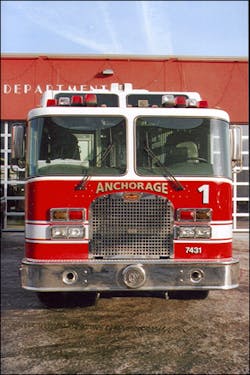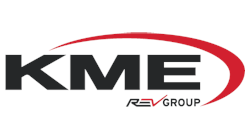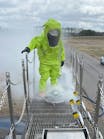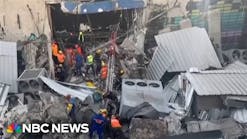Slideshow Images:
Anchorage is the largest city in the state of Alaska, composing more than two-fifths (42-percent) of the state's population. Anchorage is located in south central Alaska and is about as far north as Stockholm, Sweden or St. Petersburg, Russia and as far west as Hawaii. It lies 290 miles northeast of Kodiak Island, 130 miles south of Mount McKinley, and it is on the upper branches of the Cook Inlet, the northernmost reach of the Pacific Ocean. It is bordered on the east by Chugach Mountain State Park. Anchorage stretches from Portage Glacier to Eklutna, encompassing 1,955 square miles - about the size of the state of Delaware. Because of the location of mountain ranges it is only possible to drive north or south out of Anchorage.
The Anchorage Fire Department is a career department with 391 uniformed personnel led by Chief Craig Goodrich. The City of Anchorage has a population of approximately 277,000 and covers an area of 100 square miles inside the "Anchorage Bowl". The Anchorage Bowl consists of the main populated areas within the municipality including the hillside areas that together are somewhat bowl shaped but not including Eagle River to the north. The bowl is primarily the portion that most visitors would think is the City of Anchorage without knowing that much of the park and uninhabited lands were also part of the city. Volunteer fire departments cover the outlying areas of Anchorage. EMS coverage provided by the Anchorage Fire Department encompasses the entire 1,955 square miles of the city. Mutual Aid agreements exist between the Anchorage Fire Department, Ted Stevens International Airport Aircraft/Rescue/Fire, Elmendorf Air Force Base Fire Department, Fort Richardson Fire Department, Girdwood Volunteer Fire Department and Chugiak Volunteer Fire Department.
Anchorage, as with most cities in the United States, began with a volunteer fire department organized in 1915. Over the years the department evolved into a combination paid/volunteer department boasting 50 personnel by 1951 when they started providing ambulance service. Finally, in 1967, seven volunteer fire departments merged into the fully paid Greater Anchorage Borough Fire Department. The area wide paramedic program began in 1971. Governmental unification occurred in 1975 when the City of Anchorage and the Greater Anchorage Borough unified to become the Municipality of Anchorage. The Anchorage Fire Department operates 13 engine companies, five truck companies, one rescue, five water tankers, eight medic units and 12 specialty vehicles from 13 stations located throughout the city. The city is divided into three battalions with a chief over each. EMS paramedic transport service is provided by the Anchorage Fire Department. Seven engine companies provide non-transport basic life support (BLS) and are equipped with a semi-automatic defibrillator to enhance response to cardiac emergencies. Five engine companies provide non-transport advanced life support (ALS) services. The department has 66 trained firefighter/paramedics. Additional services are provided with special teams including dive, foam, hazmat, mountain and water rescue. Personnel for specialty teams are provided from other in-service companies when needed.
Anchorage officially formed their hazardous materials team and placed it in service in 1982 when several members showed an interest in the emerging field of hazmat response. The hazardous materials team responds to an average of 112 hazardous materials calls a year with an additional 478 alarms for gas detection monitoring. Statistics for hazmat responses do include local engine runs for hydrocarbon fuel spills and natural gas leaks. Engine companies carry absorbents for fuel spills and clean-up. The Anchorage Hazardous Materials Team covers the entire 1,955-square-mile city and is available to respond anywhere needed in the State of Alaska. The team is known as the "Pride of Alaska". The city is also home to two military installations, Elmendorf Air Force Base and Fort Richardson Army Base, which have their own fire protection, EMS and hazardous materials response units.
Vehicle(s)
Hazmat vehicles include a 2004 KME Custom on a heavy rescue chassis and a one-ton pickup with a crew cab to tow two three-tent mass decontamination systems in trailers. Hazmat 1 has a specially designed work area with an exhaust fume hood and extra heaters to accommodate Alaska's cold climate. Hazmat 1 is housed at Station One located at 122 East 4th Avenue (corner of 4th and Barrow) which is also the Headquarters Station. Other equipment at Station One includes Engine 1, Medic 1, Truck 1 and Engine 2. The Federal Bureau of Alcohol, Tobacco & Firearms (ATF) also keeps one of their response vehicles at Station One.
Staffing
The Anchorage Hazmat team is a non-dedicated team staffed with 15 on-duty personnel from Station One. All firefighters on the department are certified to the operations level. All hazmat team members work a 24-hour on and 48-hour off shift. To request to become a Hazmat member a firefighter must have completed their probationary year with the Anchorage Fire Department. They must obtain technician level certification prior to assignment to the team.
Training Requirements
Training is conducted in house and includes the Environmental Protection Agency (EPA) 40-hour technician program. Annual training involves 60 to 75 hours. Ten members of the hazmat team have completed National Fire Academy Chemistry of Hazardous Materials class and six have completed the Hazmat ALS course. Training and joint exercises are periodically conducted with the U.S. Coast Guard and Pacific Strike Team out of San Francisco. The Anchorage hazmat team also works closely with the National Guard Civil Support Team stationed in Anchorage.
Monitoring Instruments & Identification Equipment
Monitoring capabilities include:
- LTX 312, 412 multi-gas monitors
- Manning Systems portable detectors for Chlorine and Ammonia
- Mini RAE PPM and PPB PID's
- Ludlum and Victoreen radiation survey meters
- QuantRad Ranger radionuclide identification
- Travel IR
- Hazmat Id
Terrorist Agent ID:
- First Defender
- Chemical Agent Monitor (CAM)
- APD 2000
- M-8
- M-9
- 256A Kits
Personnel Protective Equipment
Level A
- Kapplar Responder and Tychem TK Commander EX
Level B
- Kapplar Hooded Coveralls
Respiratory Protection
- Draeger SCBA with 60 minute bottles
Research Resources
Computer Software Programs
- CAMEO
- Chemknowledge
- Micromedex
- PEAC-WMD
- ERG
- NIOSH Pocket Guide
- NFPA Hazmat Quick Guide
- United States Coast Guard CHIS Manual
- Emergency Handling of Hazardous Materials in Surface Transportation
Hard Copy Reference Books
- ACGIH Guide of Occupational Exposures
- CFR 49
- Chem-Bio Handbook
- CHRIS (Coast Guard Manual)
- Emergency Action Guides
- Emergency Care for hazardous Materials Exposure
- Emergency Handling of hazardous Materials
- Emergency Response Guide Book
- Fire Protection Guide to Hazardous Materials
- Guide to Selection of Chemical Agent and Toxic Industrial Materials
- Detection Equipment for Emergency Responders
- Guidelines for Selection of Chemical Protective Clothing
- Hawley's Condensed Chemical Dictionary
- Hazardous Materials Desk Reference
- Hazardous Materials Response Handbook
- Hazmat Field Guide
- Medical Management of Chemical Casualties
- Medical Management of Biological Casualties
- Merck Index
- NIOSH Pocket Guide
- Quick Action Guide to Chemical Clothing
- SAX's Dangerous Properties
Standard Operating Procedures/Guidelines
Check with Anchorage Fire Department Hazmat for specific SOP/SOG's
Hazardous Materials Exposures
Anchorage and most of Alaska are unique in terms of hazardous materials exposures. There are no interstate highways or rail systems. There is no land connection with the continental United States except through Canada. There is very little truck transportation of hazardous materials except for local use. One major road provides the only access in and out of Anchorage and runs North and South. Most hazardous materials that enter the state come through one of its ports. Anchorage is one of Alaska's busiest ports. Hazardous materials that come into the Port of Anchorage are loaded onto trucks and railroad cars to be shipped to Anchorage and other parts of the state for end use. Anchorage does not have much industry outside of the port facility and fishing-related businesses. The only chemical industry is oil related and some minimal anhydrous ammonia manufacture. Propane, anhydrous ammonia, chlorine and petroleum products are the major hazardous materials found in Alaska. Most of the large-tank storage of hazardous materials involves jet fuel, as one in every three residents of Alaska is a pilot and there is a huge volume of private and commercial aircraft activity in the state. Anhydrous ammonia and chlorine are shipped into the state in one-ton containers. Propane is shipped in by sea from Seattle and moved by railroad car into Anchorage from the port. Explosives used for construction and mining are brought in by ship and the fire department is required by the Coast Guard to stand by during off loading. There are limited amounts of radioactive materials, usually related to medical and industrial usage. Sodium hydroxide and sulfuric acid leaks related to the petroleum industry and railroad car leaks of acids and bases make up a large portion of hazardous materials responses. The Anchorage Hazmat team also responds to clandestine methamphetamine laboratories to assist police in dealing with hazardous chemicals.
Major Hazmat Incidents
Several major hazmat incidents have occurred in Anchorage since 1990. On May 20, 1992, a Freon leak occurred at an ice skating rink. Freon is a gas that can displace oxygen in the air and cause asphyxiation. Thirty-three people were exposed to the leaking Freon inside the rink. A worker who entered the compressor room to shut down the refrigeration system where the leak occurred was overcome and died. Two other workers were overcome and unconscious, but were rescued by firefighters and recovered. Following the incident, Alaska State Department of Labor officials issued citations to the mall management that included 48 health and safety violations. Fines related to the health and safety issues amounted to $87,000.
On November 27, 1997, a backhoe operator hit a 500-gallon above-ground propane storage tank and knocked off the pressure relief valve. A worker from the propane company suffered frostbite on his hand while trying to plug the leak in the tank. Propane, when stored, is at ambient temperatures so what ever the outside temperature is, that's what the temperature of the propane is as well. Discharge of a pressurized gas also has the effect of lowering the temperature of the material. The neighborhood was evacuated by firefighters and the air was monitored for propane. Ignition sources were secured and utilities turned off as a precaution.No fire occurred.
Dry Decontamination
Anchorage firefighters have developed a method of decontaminating personnel during extreme cold conditions, using "dry decontamination" procedures. These procedures are used when personnel are exposed to a gaseous atmosphere or are not significantly contaminated by a product. Positive-pressure ventilation (PPV) fans are set up to blow off any residual gas that may be pocketed anywhere on the suit. Personnel then step into a large plastic bag that has been pre-positioned on a tarp and are assisted by other team members to remove their suits. The person within the suit does not take part in the removal. Other team members roll the suit with the contaminated side away from the wearer.Once the suit is rolled all the way down, the wearer steps out of the suit. The suit is then packaged within the plastic bag and properly disposed of.
Contact Information For additional information or questions, contact: Battalion Chief Wade Strahan by e-mail at [email protected] or by phone at 907-267-5052.
Slideshow Images:







